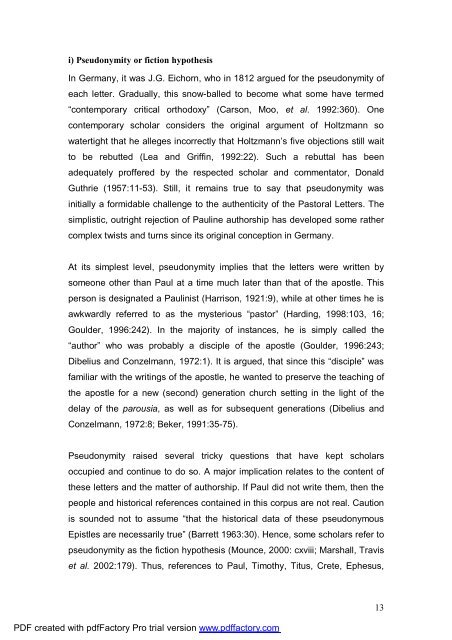A Text centred rhetorical analysis of Paul's Letter to Titus
A Text centred rhetorical analysis of Paul's Letter to Titus
A Text centred rhetorical analysis of Paul's Letter to Titus
You also want an ePaper? Increase the reach of your titles
YUMPU automatically turns print PDFs into web optimized ePapers that Google loves.
i) Pseudonymity or fiction hypothesis<br />
In Germany, it was J.G. Eichorn, who in 1812 argued for the pseudonymity <strong>of</strong><br />
each letter. Gradually, this snow-balled <strong>to</strong> become what some have termed<br />
“contemporary critical orthodoxy” (Carson, Moo, et al. 1992:360). One<br />
contemporary scholar considers the original argument <strong>of</strong> Holtzmann so<br />
watertight that he alleges incorrectly that Holtzmann’s five objections still wait<br />
<strong>to</strong> be rebutted (Lea and Griffin, 1992:22). Such a rebuttal has been<br />
adequately pr<strong>of</strong>fered by the respected scholar and commenta<strong>to</strong>r, Donald<br />
Guthrie (1957:11-53). Still, it remains true <strong>to</strong> say that pseudonymity was<br />
initially a formidable challenge <strong>to</strong> the authenticity <strong>of</strong> the Pas<strong>to</strong>ral <strong>Letter</strong>s. The<br />
simplistic, outright rejection <strong>of</strong> Pauline authorship has developed some rather<br />
complex twists and turns since its original conception in Germany.<br />
At its simplest level, pseudonymity implies that the letters were written by<br />
someone other than Paul at a time much later than that <strong>of</strong> the apostle. This<br />
person is designated a Paulinist (Harrison, 1921:9), while at other times he is<br />
awkwardly referred <strong>to</strong> as the mysterious “pas<strong>to</strong>r” (Harding, 1998:103, 16;<br />
Goulder, 1996:242). In the majority <strong>of</strong> instances, he is simply called the<br />
“author” who was probably a disciple <strong>of</strong> the apostle (Goulder, 1996:243;<br />
Dibelius and Conzelmann, 1972:1). It is argued, that since this “disciple” was<br />
familiar with the writings <strong>of</strong> the apostle, he wanted <strong>to</strong> preserve the teaching <strong>of</strong><br />
the apostle for a new (second) generation church setting in the light <strong>of</strong> the<br />
delay <strong>of</strong> the parousia, as well as for subsequent generations (Dibelius and<br />
Conzelmann, 1972:8; Beker, 1991:35-75).<br />
Pseudonymity raised several tricky questions that have kept scholars<br />
occupied and continue <strong>to</strong> do so. A major implication relates <strong>to</strong> the content <strong>of</strong><br />
these letters and the matter <strong>of</strong> authorship. If Paul did not write them, then the<br />
people and his<strong>to</strong>rical references contained in this corpus are not real. Caution<br />
is sounded not <strong>to</strong> assume “that the his<strong>to</strong>rical data <strong>of</strong> these pseudonymous<br />
Epistles are necessarily true” (Barrett 1963:30). Hence, some scholars refer <strong>to</strong><br />
pseudonymity as the fiction hypothesis (Mounce, 2000: cxviii; Marshall, Travis<br />
et al. 2002:179). Thus, references <strong>to</strong> Paul, Timothy, <strong>Titus</strong>, Crete, Ephesus,<br />
PDF created with pdfFac<strong>to</strong>ry Pro trial version www.pdffac<strong>to</strong>ry.com<br />
13

















